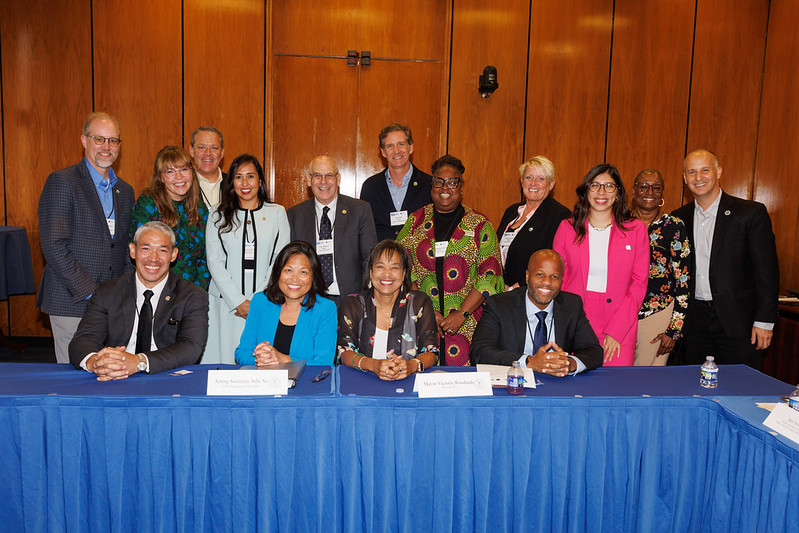Good jobs in great cities
 In July 2023, the National League of Cities (NLC) and the U.S. Department of Labor gathered teams from across the country to discuss how once-in-a-generation federal investments in America’s infrastructure can connect people to good jobs. A year later, we brought these 16 cities to Washington, D.C. to wrap up the Good Jobs, Great Cities Academy, a year-long initiative focused on building equitable pathways to high-quality jobs.
In July 2023, the National League of Cities (NLC) and the U.S. Department of Labor gathered teams from across the country to discuss how once-in-a-generation federal investments in America’s infrastructure can connect people to good jobs. A year later, we brought these 16 cities to Washington, D.C. to wrap up the Good Jobs, Great Cities Academy, a year-long initiative focused on building equitable pathways to high-quality jobs.
With the goal of celebrating, sharing and planning for the future, we spent two days with mayors, city staff and local partners representing K-12 and postsecondary education, workforce development boards, community-based organizations, organized labor and employers.
The city teams had a lot to celebrate – both big and small. From breakthrough conversations, first of their kind convenings and collaborations with partners and employers, to multiple program and platform launches, the Good Jobs, Great Cities initiative helped city leaders set foundational groundwork for building and scaling opportunity infrastructure.
In Jamestown, New York, the team leveraged American Rescue Plan Act funding to support manufacturers and related workforce initiatives. Equipment and machinery grants have supported manufacturers in the community, enabled retention and increased employment in the sector. In San Antonio, Texas, the team launched an innovative childcare pilot, a property tax exemption, and employer-led construction and manufacturing bootcamps. Increased employer engagement led to the formation of a manufacturing sector table and the active, ongoing development of a local sector strategy in Duluth, Minnesota. The Missoula Clean Energy Coalition in Missouri developed curriculum and secured funding for a new apprenticeship readiness program.
The Good Jobs, Great Cities results are undeniable.
-
A participant from St. Louis, Missouri praised the initiative, saying, “Our project was just a vision, but our participation led to concrete accomplishments that turned the vision into reality. A once-desolate location is now seeing daily activity as construction and programmatic designs are beginning to materialize.”
-
A participant from Frederick, Maryland, credited the initiative for helping them develop a new framework to create new opportunities, saying: “We now have a framework to bring community partners to the table, recognize service gaps, and develop sustainable plans to live our values/help disconnected members of our community.”
-
In Tempe, Arizona, a participant said, “Our team is most proud of our collaborative efforts in gathering and analyzing data to drive our work. This collaboration resulted in our ability to unite partners at the first Tempe Manufacturing Summit, where educational providers, employers, City departments, and other stakeholders shared their perspectives about workforce needs and partnership opportunities…The Workforce Education Pathway Model provided stakeholders with a visual representation of the opportunities in Tempe to feed the talent pipeline.”
Acting Secretary of Labor Julie A. Su, Employment and Training Administration Assistant Secretary José Javier Rodríguez and NLC leaders joined public and private sector leaders from around the country last month to discuss how to build on the successes of the past year. Below are five key takeaways from our conversations.
-
Mayoral and local elected leaders are critical champions and conveners for economic mobility.
-
Cities can collaboratively build opportunity infrastructure by investing in wrap-around supports to tackle barriers such as lack of childcare, transportation and mental health treatment.
-
Apprenticeship and sector strategy frameworks can help cities build quality, sustainable local career pipelines.
-
Cities have unique, local levers to inspire sustainable, high-quality workforce development through procurement, programs and policy.
-
Municipalities have both a crisis and opportunity in terms of how they address their own workforce challenges and how they can be model employers.
So, what comes next for Good Jobs, Great Cities? We hope to continue to highlight the learnings of the cities and ensure that the alumni are connected to the full breadth of department resources. For example, five mayors who attended the convening were able to sign on to our Good Jobs Principles. By signing on to the Good Jobs Principles, mayors have committed to expanding opportunities in their cities to promote good quality jobs that are accessible to all communities, with the support of federal investments.
Britt Stich is the deputy assistant secretary for the U.S. Department of Labor’s Employment and Training Administration. McKinzie McGuire is a postsecondary and workforce success senior program specialist for the National League Cities.
McGinnis.Laura…
Fri, 09/06/2024 – 11:41


Comments are closed.